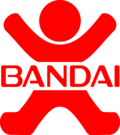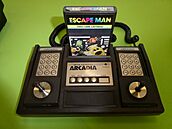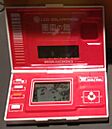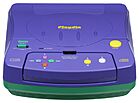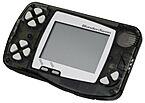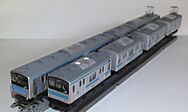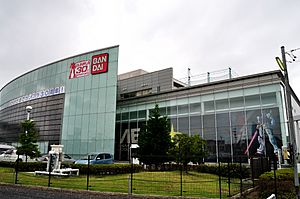Bandai facts for kids

Logo used since 1983
|
|
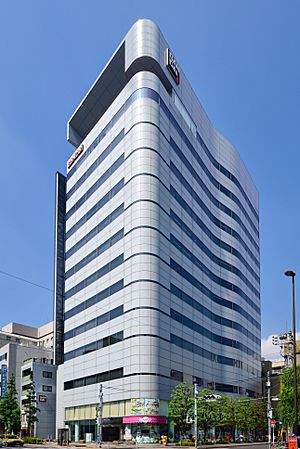
Bandai's corporate headquarters in Taitō, Tokyo
|
|
|
Native name
|
株式会社バンダイ
|
|---|---|
|
Romanized name
|
Kabushiki-gaisha Bandai |
|
Formerly
|
Bandai-ya |
| Subsidiary | |
| Industry | Entertainment |
| Founded | July 5, 1950 |
| Founder | Naoharu Yamashina |
| Headquarters | Taitō, Tokyo, Japan |
|
Key people
|
Masaru Kawaguchi (president) |
| Products |
|
| Brands |
|
|
Operating income
|
|
|
Number of employees
|
851 (January 2021) |
| Parent | Bandai Namco Holdings (2005–present) |
| Subsidiaries |
|
| Footnotes / references |
|
Bandai Co., Ltd. is a big Japanese company that makes and sells toys. Its main office is in Taitō, Tokyo, Japan, but it has many offices all over the world.
Since 2005, Bandai has been the toy-making part of Bandai Namco Holdings. This group is currently the second largest toy company in the world based on how much money they make. From 1981 to 2001, Bandai also made video game consoles.
Bandai was started by Naoharu Yamashina, a veteran from World War II. He founded it as Bandai-Ya on July 5, 1950. The company first sold metal toys and rubber swimming rings. Later, they started making metal cars and airplane models. In 1961, the company changed its name to Bandai Co., Ltd. They became very successful with their action figures based on the anime show Astro Boy.
The Story of Bandai
How Bandai Started and Grew (1947–1968)
In 1947, Naoharu Yamashina began working for a company that sold textiles. He had studied business and fought in World War II. His eye was injured by a grenade during the war. The textile business was struggling after the war in Japan.
A neighbor told Yamashina about the toy industry and how much money could be made there. He became very interested. Yamashina and his wife traveled to Tokyo to learn about the toy market. They worked hard to start a small toy selling part within the textile business.
On July 5, 1950, Yamashina took full control of the toy part. It became its own company called Bandai-ya in Taitō, Tokyo. The name "Bandai" comes from a Japanese phrase meaning "eternally unchanging."
Bandai-ya sold and imported dolls, metal toys, and rubber swimming rings. Their first original product was the Rhythm Ball, a beach ball with a bell inside. It had some quality problems at first. Bandai-ya kept making better toys, like cheap metal cars and airplane models. Many of these were sent to the United States and other countries. They were some of the first "Made In Japan" products sold outside Japan.
As the company made more money, Bandai-ya grew. They built a new shipping and storage building in 1953. Later that year, they added departments for research and development (R&D) and checking product quality. In 1955, they opened a factory called Waraku Works to make more toys.
In the same year, Bandai-ya started the toy industry's first quality control system. The first toy approved by this system was a 1956 Toyopet Crown model car. This was also Bandai-ya's first product with a guarantee. The company wanted to have a friendly image. They introduced a new logo, a slogan, and TV commercials that showed off their good quality products.
Bandai-ya changed its name to Bandai in July 1961. At the same time, it started to expand overseas. The first step was opening Bandai Overseas Supply in New York City.
Bandai's toys sold well in Japan, but they became very successful in 1963. This was when they started making action figures based on the anime show Astro Boy. The success of these toys made Bandai change its plans. The company started to help fund new TV shows and advertise their tie-in action figures and costumes during the shows.
They had another huge hit with action figures of Ultraman characters. These were very popular because of the TV show. Later, these figures were released in North America, but they didn't sell as well there. In July 1966, Bandai released Crazy Foam, which sold 2.4 million units in three months. Bandai also made Thunderbird electrical vehicles, Water Motor bath toys, and the Naughty Flipper. The Naughty Flipper won a gold medal at an exhibition in New York in 1968.
Growing Bigger and Mobile Suit Gundam (1971–1983)
Bandai kept growing throughout the 1970s. In 1970, the company teamed up with model car maker Tonka to form Tonka Japan K.K. This was part of Bandai's plan to work with foreign companies. A year later, a new company called Popy was created. Popy focused on making toys based on popular children's characters.
Bandai became a major company in the Japanese toy industry. They competed with companies like Takara and Epoch. However, the leaders at Bandai believed the company needed to expand more internationally. This would help people around the world know their brand better.
Bandai Models was also started in 1971. This group specialized in making toy characters. Bandai America Inc. was set up in 1978 to handle sales and marketing in the US. In the 1980s, Bandai introduced Spacewarp. These were toy "roller coasters" that you could build yourself for rolling balls.
In May 1980, Makoto Yamashina, the son of the founder, became the president of Bandai. Naoharu Yamashina became the chairman. Makoto Yamashina changed the older staff at Bandai. He brought in younger employees to get new ideas and change the company's plans. The new president decided to sell products directly to stores instead of using other companies in between.
In July 1980, Bandai launched the 'Gundam Plastic Model'. This was based on the animated series Mobile Suit Gundam. It led to the very popular Gunpla line of model kits.
Entering the Video Game World (1983–1989)
In 1985, Bandai became one of the first companies to make games for Nintendo's Family Computer. One of their first games was Tag Team Match: MUSCLE. This game was based on the Kinnikuman manga and sold over one million copies.
Bandai also made the Family Trainer Pad, which was called the Power Pad outside Japan. This product also sold very well. A series of games were released for it, including Athletic World and Stadium Events for the NES. Nintendo later bought the rights to the mat in North America and made their own version, the Power Pad.
Stadium Events was taken off shelves quickly and is now considered one of the rarest licensed NES games in North America. A sealed copy of the game sold for over $41,000 in 2010. Its sister game, Athletic World, was later re-released to work with the Power Pad. Stadium Events was not released again by its original name. Instead, it was slightly changed and became the game included with the Power Pad, World Class Track Meet.
Since the 1980s, Bandai has been the top toy company in Japan. They hold the main toy licenses for many popular characters. These include Daikaiju, Ultraman, Super Robot, Kamen Rider, the Super Sentai and Power Rangers series, and Gundam. In February 1989, Bandai bought a company called Coreland and renamed it Banpresto. This became Bandai's division for coin-operated games.
Big Success and Growth (1989–1995)
By 1989, Bandai was celebrating its 39th anniversary. Makoto Yamashina talked about a vision for "Bandai Land," a fun park like those from Disney. Bandai decided to change its focus from just being a toy company to an entertainment company, hoping to become "Japan's Disney."
In the same year, Bandai faced some money problems. They partnered with Coreland, a video game company, to get into the arcade game business. Coreland was also having financial difficulties, with over ¥1.5 billion in debt. Instead of backing out, Bandai decided to buy most of Coreland in February 1989. They reorganized it into their own video game publishing and development division, Banpresto. The name "Banpresto" combines "Bandai" and "presto," a word for magic.
Joining Forces with Namco (2005–Present)
After joining with game developer and arcade operator Namco in 2005, Bandai is now part of Bandai Namco Holdings. Following a big change in the group in 2006, Bandai leads the group's Toys and Hobby business.
In April 2014, Bandai's parent company, Namco Bandai Holding, announced that Bandai's video games, like Dragon Ball and One Piece, would no longer be sold under the Bandai name. Instead, they became part of the Namco Bandai Games division.
In February 2018, Saban Brands and Bandai's US division announced they would not renew their main toy license for Power Rangers. This change happened in Spring 2019, and another toy company, Hasbro, took over the license. This did not affect Bandai Japan's license for Super Sentai (the series that Power Rangers uses footage from) with Toei.
A sister company, Bandai Spirits, was created on February 15, 2018. On April 1, 2018, the part of Bandai that made products for older customers (like figures and plastic models) and Banpresto's prize business moved to Bandai Spirits.
In August 2024, Bandai Namco Holdings announced a partnership with TOHO Co., Ltd.. This alliance aims to improve their global strategy for popular characters and stories. They plan to work together on planning, developing, and selling related content and products.
Cool Products from Bandai
Scale Models
Bandai makes detailed scale models.
Star Wars Models
Bandai has created model kits for these Star Wars vehicles and characters:
- Millennium Falcon
- X-Wing
- Y-Wing
- Tie fighter
Toys
- S.H.Figuarts action figure line
- Kira Yamato
- Lacus Clyne
- Demon Slayer: Kimetsu no Yaiba Action Figures
- Tanjiro and Nezuko (2024)
- “Pocoyo” related products (2010-2012)
How Bandai is Organized
Bandai's main office is in Taitō, Tokyo, Japan. The company has offices in many countries, including the United States (Bandai America), Mexico, the United Kingdom, Indonesia, France, Spain, Taiwan, and mainland China.
Bandai is fully owned by Bandai Namco Holdings. It leads its parent company's Toy and Hobby business unit.
Bandai is one of the biggest and most successful toy companies in the world, along with Hasbro and Mattel. The company focuses on making unique and new products for its customers. They aim to break away from old ideas in the industry. Their slogan, "Break out of the box," shows this goal.
Bandai's Other Companies
Bandai Spirits Co., Ltd. makes figures and plastic models for older fans. They use popular characters from shows like Mobile Suit Gundam, One Piece, Pokémon, Kirby, Disney, Star Wars, Hatsune Miku, Dragon Ball, Demon Slayer, Kamen Rider, Super Sentai, Ultraman, and My Hero Academia.
Bandai also makes candies, board games, and capsule toys through its company MegaHouse Corporation. MegaHouse also sells toys and figures under its MegaToy brand. MegaHouse holds the license for the Rubik's Cube in Japan and has made many different versions of the toy just for Japanese people. The Plex company creates manga series, TV shows, and products based on characters.
See also
 In Spanish: Bandai para niños
In Spanish: Bandai para niños
- List of game manufacturers
- Fisher-Price
- Hasbro
- LEGO
- Mattel
- Spin Master
- MGA Entertainment
- TOMY



